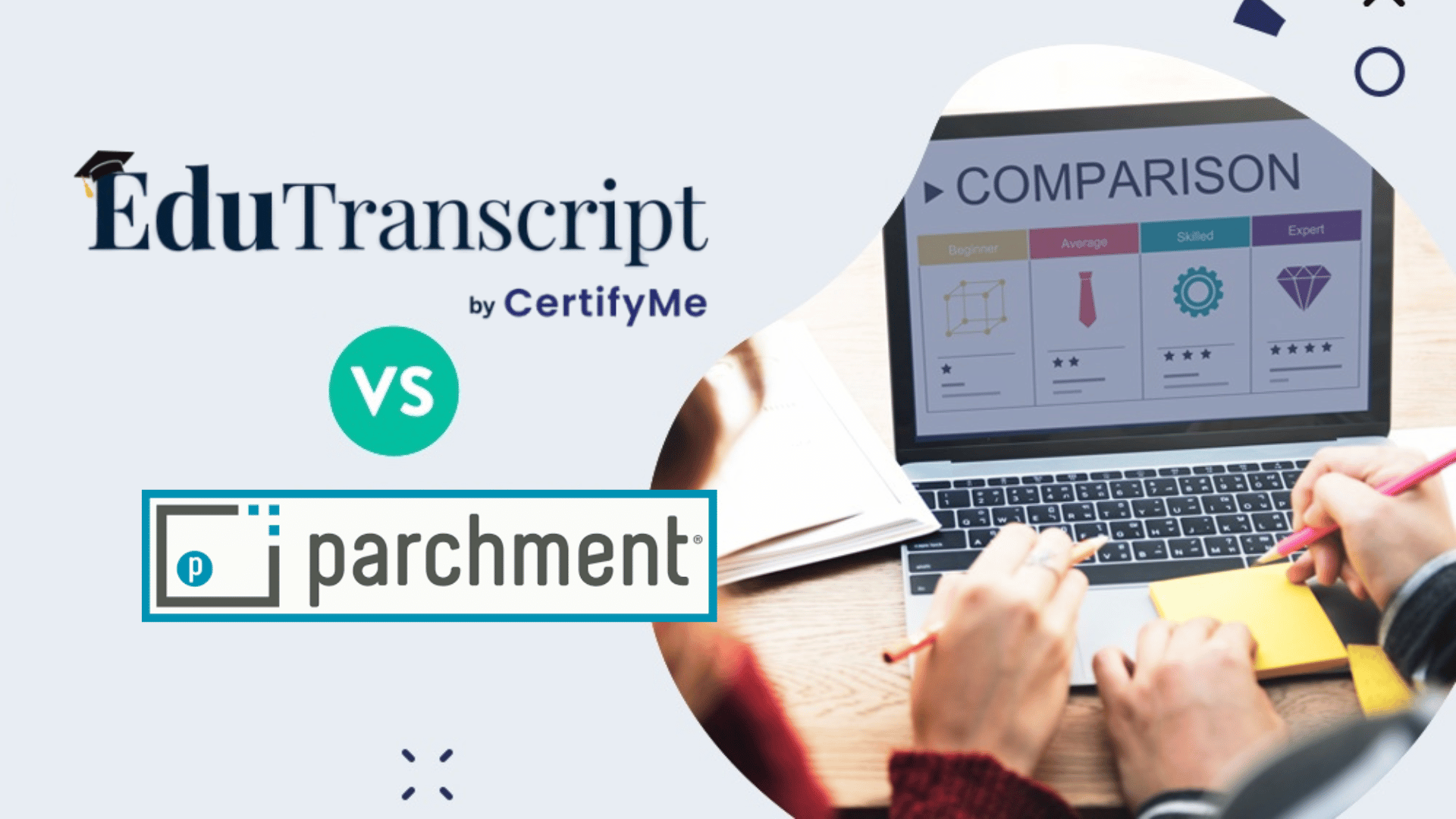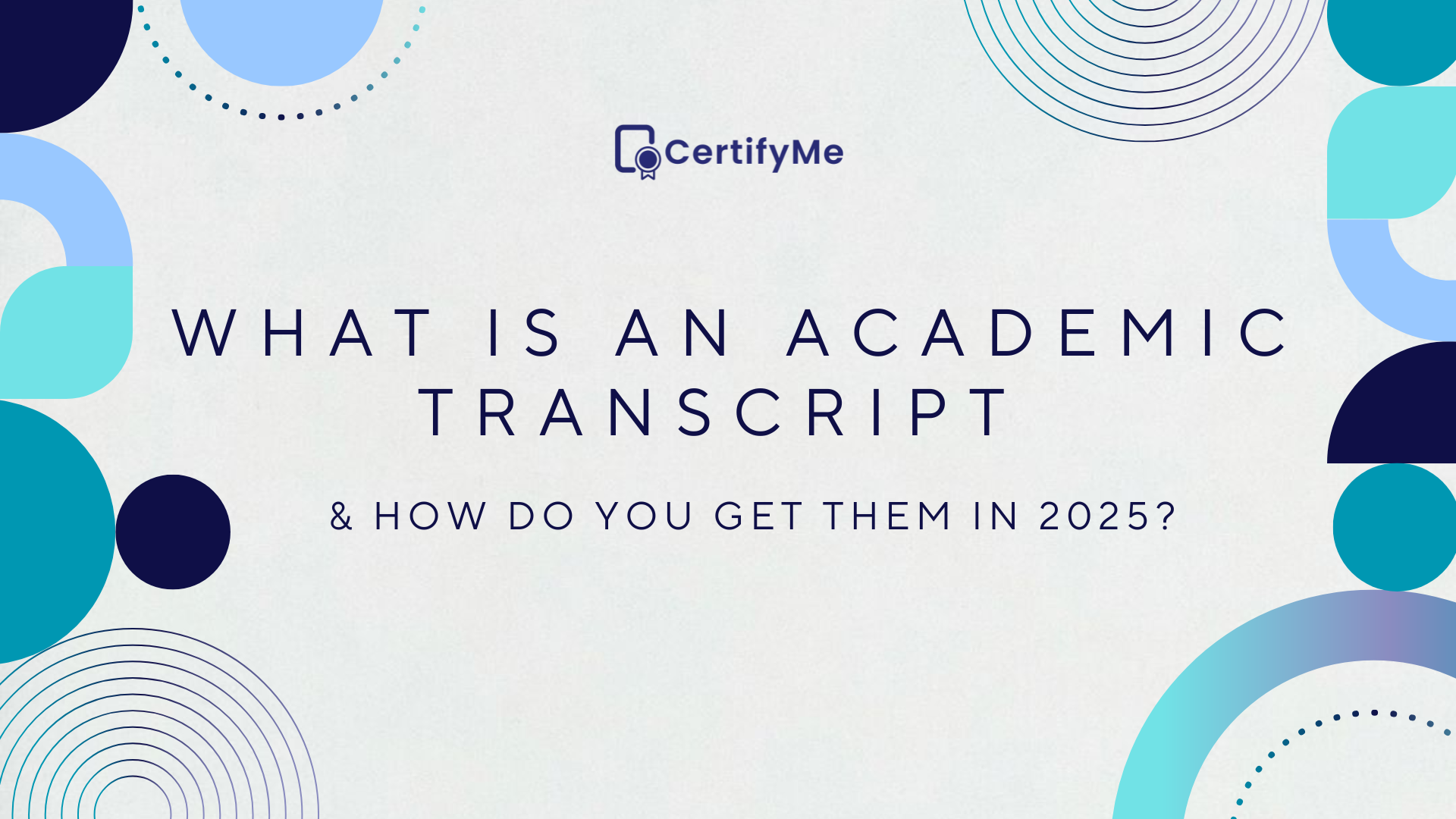So, you’re either managing transcripts for a university or waiting on your own to be delivered—and someone brings up Parchment or EduTranscript.
At first glance, they seem to offer similar solutions: issuing academic records, processing student requests, enabling digital delivery. But dig a little deeper, and the differences become clearer.
Both are reputable transcript management platforms, but they cater to different institutional needs. Whether you’re an administrator trying to streamline operations or a student hoping for a hassle-free experience, understanding what each platform offers is essential.
EduTranscript was built around what we believe institutions need for secure, verifiable, and efficient transcript management. But we also understand it may not be the ideal fit for every university and that’s exactly why this comparison exists.
This blog isn’t about promoting one over the other. Instead, it’s a balanced comparison to help you identify which solution fits best with your university’s or department’s priorities.
TL;DR
Parchment – Pros
-
Widespread Adoption
Trusted by thousands of U.S. institutions with broad familiarity among registrars and students. -
Strong U.S. Compliance Alignment
Well-suited for institutions that require built-in support for U.S. - specific regulatory needs. -
Established Sending Network
Has an extensive network for transcript delivery and partnerships with schools, colleges, and application portals across the U.S.
Parchment – Cons
-
Frequent Physical Delivery Delays
Students often report delays or issues with receiving physical transcripts on time. -
Hard-to-Reach Customer Support
Registrar teams and students often get stuck with automated replies instead of reaching a real person for help. -
Limited Real-Time Tracking
The system doesn’t offer intuitive, real-time updates on the status of transcript requests.
EduTranscript – Pros
-
High-Security Digital Transcript Architecture
Offers tamper-proof, digitally signed transcripts with instant verification to prevent fraud. -
24×7 Live Human Support
Students and staff have access to responsive, round-the-clock human support for faster issue resolution. -
Customizable to Institutional Needs
The platform adapts to your university’s specific workflows, compliance protocols, and process preferences.
EduTranscript – Cons
-
Newer in the Market
Has a smaller but growing presence compared to long-established platforms. -
Hands-On Onboarding
Custom implementation may require more initial engagement from your registrar team.
Choosing the Right Platform:
If your institution is seeking a widely adopted U.S. platform that integrates easily and understands local compliance needs, Parchment may be a familiar and effective choice.
If you need a solution with strong emphasis on security and compliance, minimal risk of transcript fraud, 24×7 live human support for both students and staff, and a system that is customizable to your institution’s unique requirements, EduTranscript is likely the better fit.
Where Parchment Shines: The Tried-and-Tested Veteran

Parchment has earned its reputation over years of serving diverse educational institutions. Its ability to handle bulk transcript issuance efficiently makes it an ideal choice for schools and universities with high transaction volumes.
Here’s what Parchment does well:
-
Scalability:
The platform is equipped to process thousands of transcript requests simultaneously, making it especially valuable during peak times like graduation or application seasons. -
Widespread Adoption:
Most administrative staff and students in the U.S. have interacted with Parchment at some point, making the learning curve relatively smooth.
For institutions with heavy, consistent traffic and a need for system-wide standardization, Parchment often delivers the familiarity and breadth they require.
While Parchment has many strengths, it’s not without drawbacks—many of which are voiced by users themselves, particularly in online forums and review platforms.
Here are the most common concerns:
-
Customer Support Accessibility:
Many users, especially registrars and students report that it’s difficult to speak with a human representative. Automated responses and support loops can delay resolution. -
Delivery Delays:
There are frequent complaints about the slow pace of transcript delivery, particularly when physical documents are involved. In some cases, students have even received damaged documents. -
Limited Transparency:
Tracking the progress of a transcript request isn’t always intuitive. Students and staff alike have expressed frustration with the lack of real-time status updates.
“I just wanted my transcript for a job application and ended up spending a week emailing back and forth with a bot…” — A common sentiment on user forums
These pain points highlight a broader need for responsive customer service and more transparent processing tools, particularly in time-sensitive situations.
Enter EduTranscript: A Simpler, Smarter Way to Handle Academic Records

EduTranscript enters the scene not just as a competitor—but as a digital-native alternative that aligns with the needs of modern institutions.
EduTranscript includes all the core features that institutions have come to expect from platforms like Parchment—digital delivery, SIS integration, bulk processing capabilities, and student self-service tools.
However, it was developed with a sharper focus and heavier emphasis on what many institutions today consider essential: high security, automated compliance, instant verifiability and zero chance for transcript fraud.
The result is a platform that not only meets the industry standard but also aims to improve the overall experience for both administrative staff and students through better responsiveness, real-time verification, and tamper-proof document architecture.
Built for the Digital Age
Unlike traditional platforms that retrofitted digital capabilities over time, EduTranscript was designed from the ground up for a digital-first academic landscape. Transcripts are generated, managed, and delivered entirely online—removing the dependency on physical documents.
Advanced Security Measures
EduTranscript emphasizes trust and authenticity in academic records. Every document issued:
-
Is digitally signed to prevent forgery
-
Uses ID-based tagging to trace origin and ownership
-
Comes with OTP (One-Time Password) verification to confirm recipient identity
These features help confirm:
-
Which university issued the transcript
-
Who it was issued to
-
Whether the document has been tampered with
Real-Time Verification
Employers and university admission teams can verify transcripts instantly using established digital credentialing standards like W3C and Open Badge 3.0. This reduces administrative workload while enhancing institutional credibility.
Responsive Human Support
Each institution is assigned a dedicated support manager, available 24/7, ensuring timely responses and problem-solving. Institutions with fewer but higher-quality partnerships receive more focused attention.
There are multiple customer support representatives round the clock, who are there to actively answer student queries and follow-ups.
High User Ratings
EduTranscript, as part of the CertifyMe ecosystem, consistently ranks higher than Parchment on software review platforms like G2, particularly in areas like customer satisfaction, ease of use, and support responsiveness.
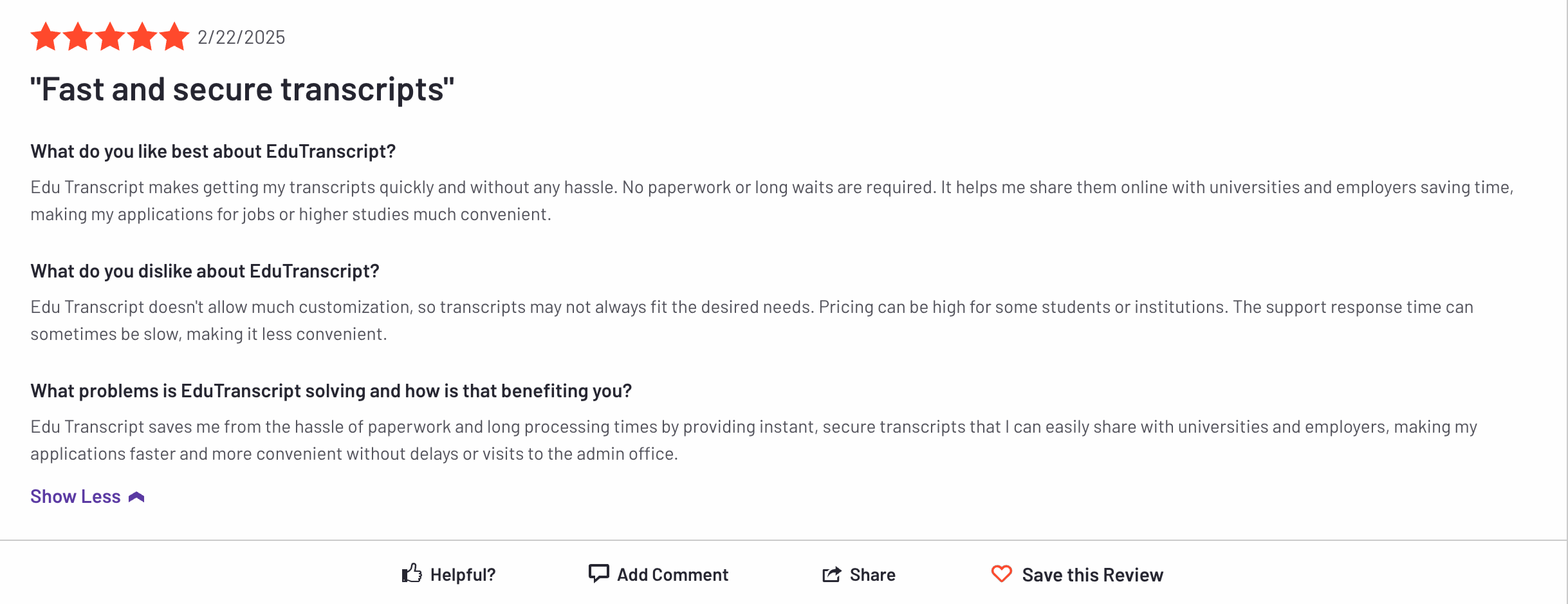
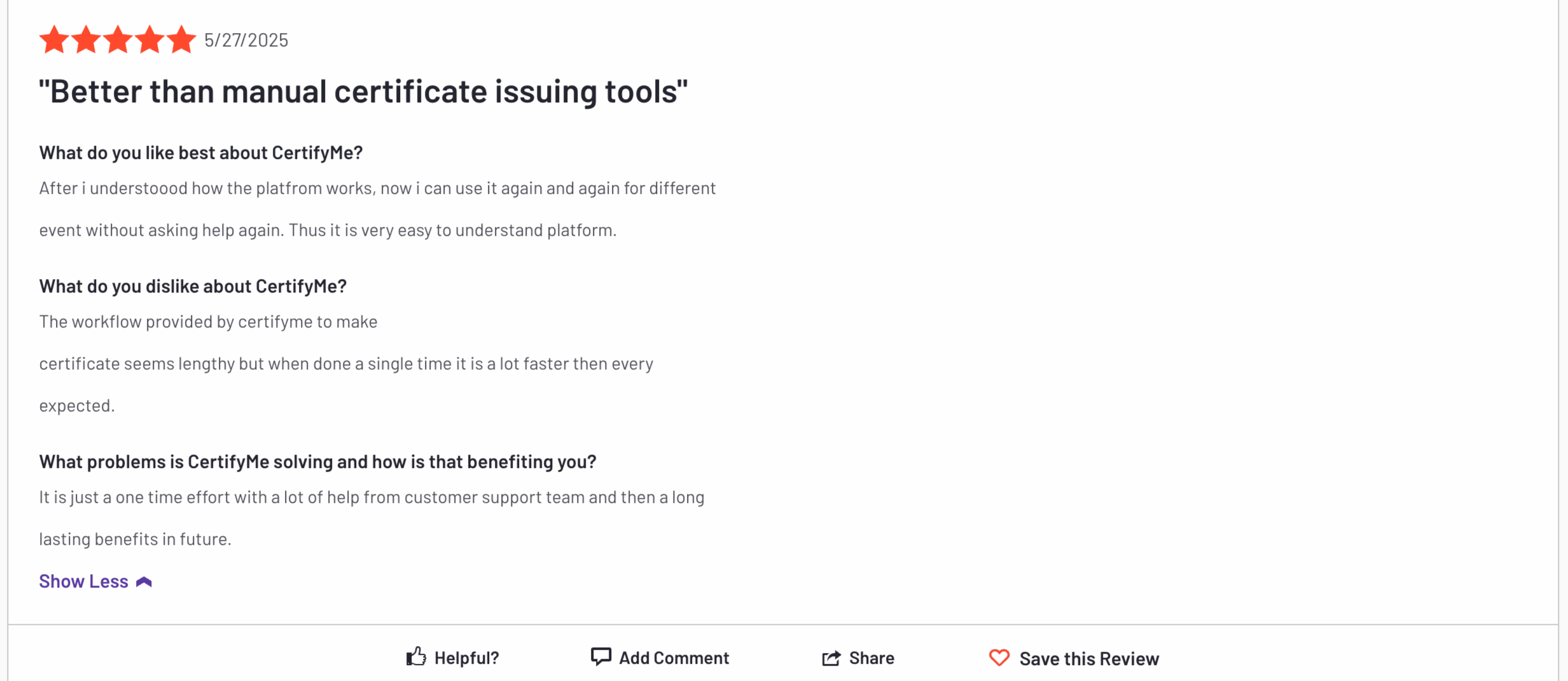
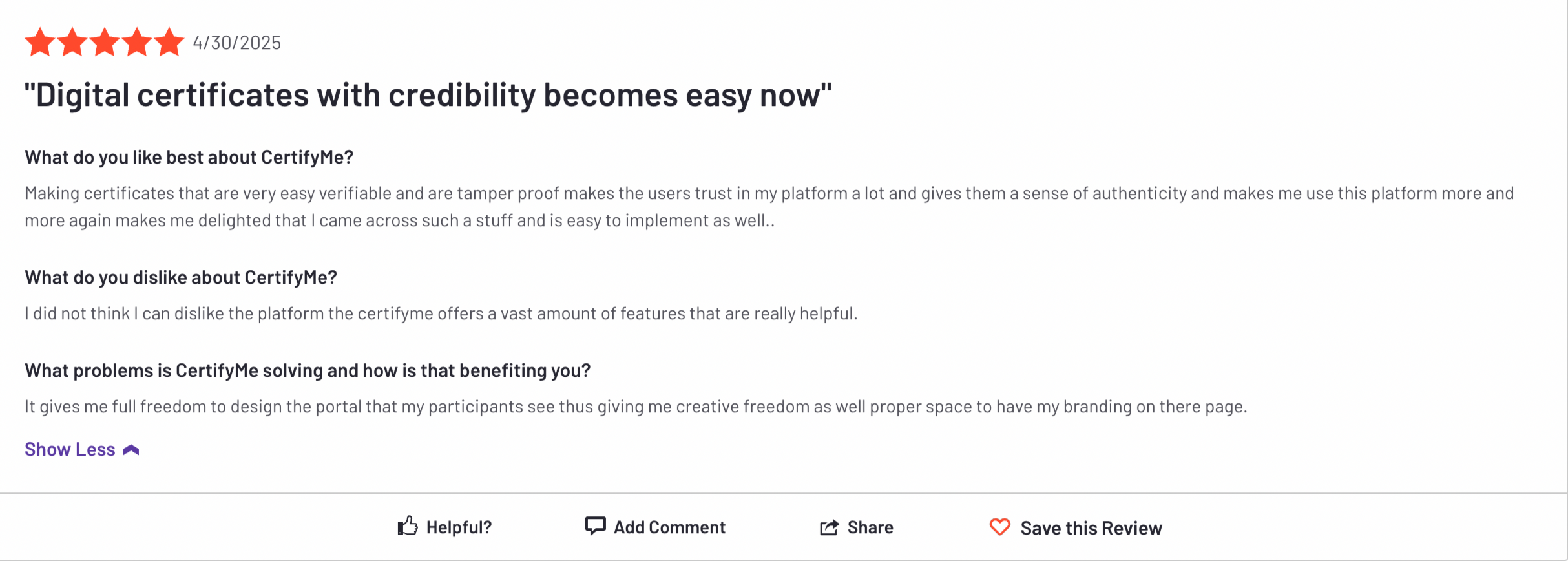
Side-by-Side Comparison: Parchment vs. EduTranscript
Below is a clear feature comparison to help institutions weigh their options:
| Feature | Parchment | EduTranscript |
|---|---|---|
| Market Presence | Strong, long-established | Emerging, niche-focused |
| Verifiability | Basic verification tools | Transcripts that can be instantly checked for authenticity, without the wait |
| Customer Support | Mostly automated | 24/7 human support for each institution |
| Data Security & Compliance | Standard protocols | Advanced encryption, tagging, and OTP |
| Ideal For | Institutions seeking scale alone | Institutions prioritizing security, compliance and verifiability along with scale |
Similarities: Core Features You’ll Find in Both Platforms
Despite their differences, Parchment and EduTranscript share many of the features most institutions require from a transcript management system:
While EduTranscript and Parchment differ in their design philosophies and operational models, they share several foundational features that any institution—large or small—would expect from a modern transcript management system.
These features are critical not just for efficiency, but also for maintaining transparency and a smooth user experience. Let’s explore the common ground they cover:
1. Integration with Student Information Systems (SIS)
Both platforms offer seamless integration with most major SIS platforms, allowing institutions to sync student records, automate workflows, and reduce manual input errors.
EduTranscript’s integrations are often more configurable, particularly for institutions that want additional control over data access and compliance protocols.
2. Centralized Dashboard for Incoming Transcript Requests
Each platform provides a unified dashboard for registrars and administrative staff to view, track, and manage transcript requests in real time.
Both have noted a cleaner interface and customizable filters, which helps staff prioritize urgent or flagged requests more efficiently.
3. Student Self-Service Portals
Students can initiate and manage their own transcript requests directly through either platform—no back-and-forth emails needed.
Both portals are functional, EduTranscript’s design leans more toward intuitive UX, offering real-time progress updates and verification options built into the request journey, while Parchment is equipped to process thousands of transcript requests simultaneously.
4. Status Tracking and Notifications
Keeping students informed about the progress of their request is a shared goal across both systems. Users receive alerts or can log in to check current status.
EduTranscript extends this functionality by offering verification alerts—so students are notified not only when a transcript is sent but also when it’s been accessed or verified by a third party (like an employer or grad school).
5. Role-Based Access Controls
Both platforms support varying levels of administrative access based on user roles. This ensures that sensitive information is handled responsibly, with restrictions based on team responsibilities.
6. Ability to Handle Large Volumes
Both platforms are equipped to process high volumes of transcript requests.
While Parchment has long been known for bulk issuance, EduTranscript also supports large-scale operations, with added oversight to ensure accuracy and prompt delivery, especially during peak periods like graduation or admissions cycles.
For institutions that are satisfied with the basics, both platforms perform adequately.
But for those looking to evolve toward a more secure, user-friendly, and transparent process, the differences may prove significant.
Curious how EduTranscript (by CertifyMe) and Parchment compare in real-world user feedback?
Below are side-by-side snapshots from G2, highlighting ratings across key areas like ease of use, support quality, and product direction, directly from verified users.
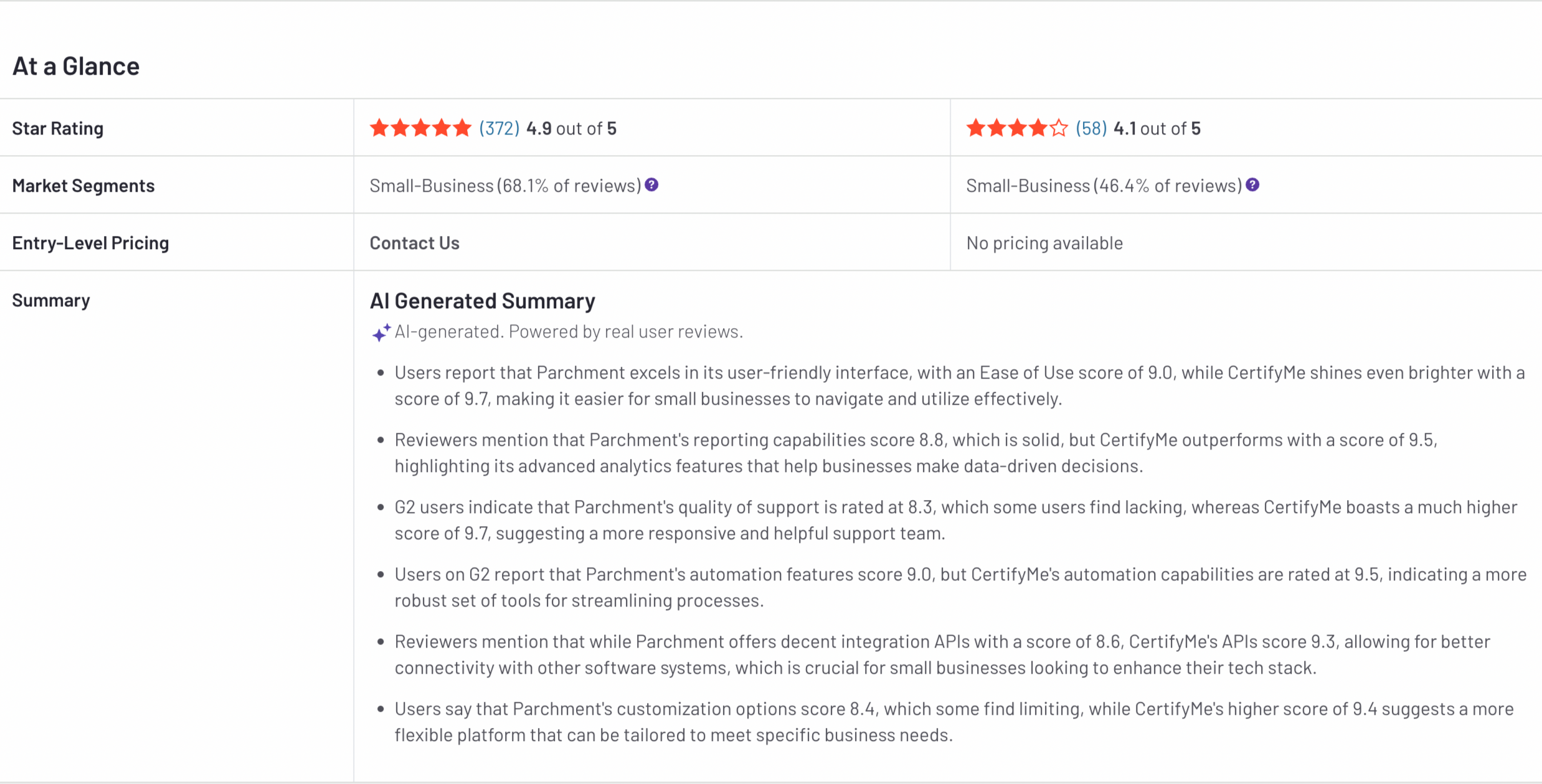
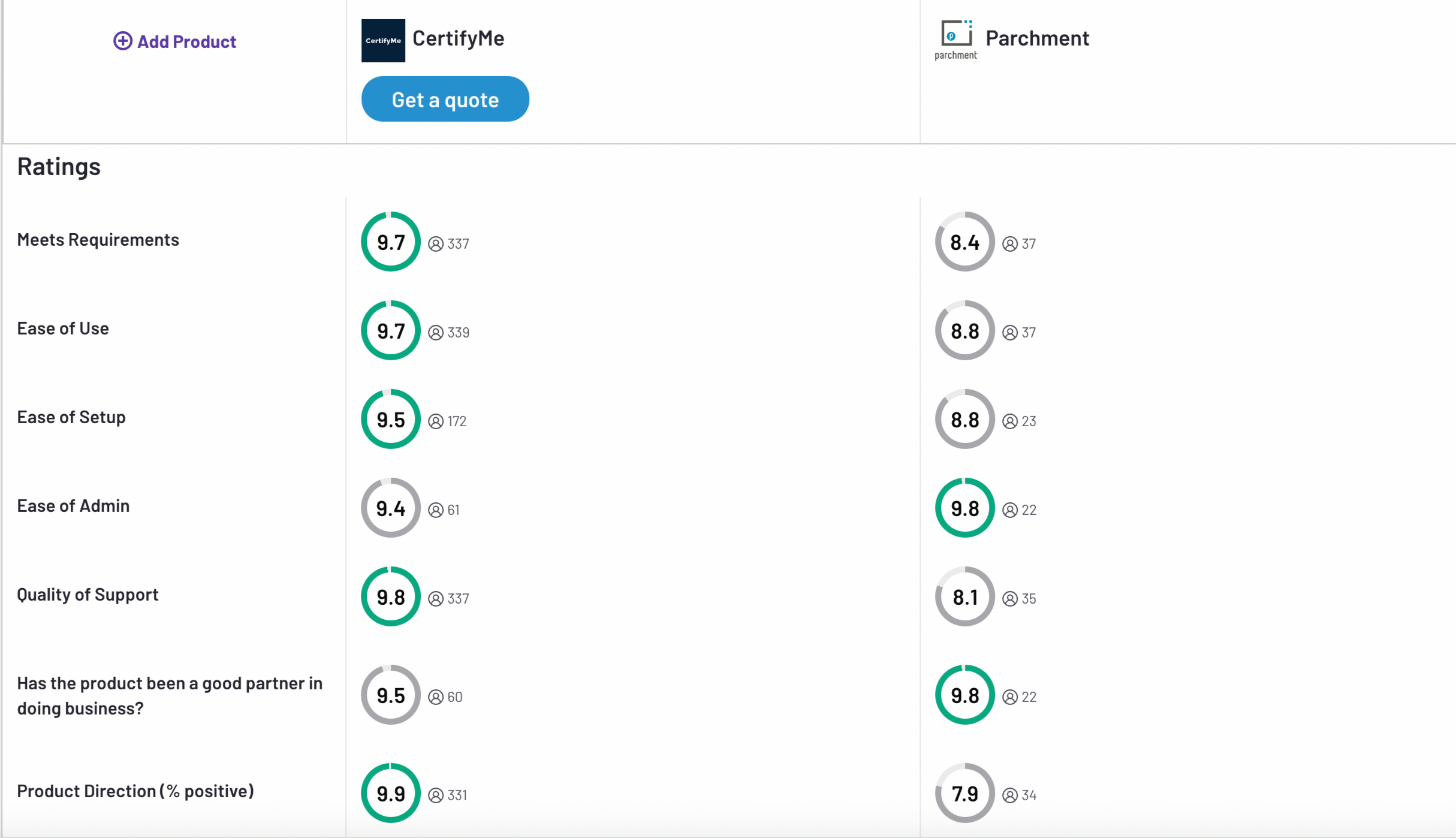
So, Which Transcript Management Platform Fits You Best?
Both Parchment and EduTranscript offer the core features you’d expect from a modern transcript management system—digital delivery, request tracking, SIS integration, and student self-service tools.
If you’re simply looking to handle high volumes of transcript requests with a familiar and widely adopted solution, Parchment might be the right fit, especially for large institutions already embedded in its ecosystem.
On the other hand, EduTranscript brings a more tailored and security-forward approach. With real-time verification, tamper-proof technology, and dedicated human support, it’s a platform that prioritizes the integrity and traceability of academic records, particularly valuable for institutions focused on compliance and credibility in a digital world.
That said, there’s no one-size-fits-all answer here. Your choice depends on what your team and your students need most—scale or precision, legacy familiarity or modern control.
If you’re still unsure, it’s worth exploring both platforms firsthand. Most institutions benefit from speaking directly with product teams, seeing demos, and evaluating real use cases.
After all, the best platform is the one that aligns with your values, processes, and the experience you want to provide for your students.
.png)
 Author :
Author : 